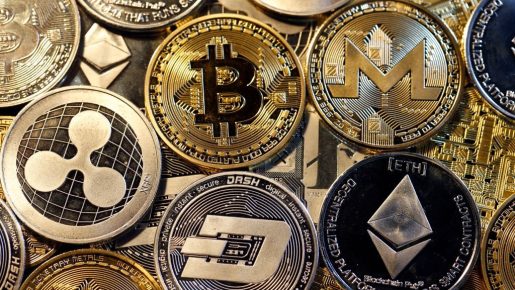One type of currency that only exists digitally is called cryptocurrency. In addition to being used as an investment, cryptocurrency may be used to make payments online without the need for a middleman like a bank. When you’re just starting out in the world of cryptocurrencies, it can be overwhelming because there are dozens of different cryptocurrencies, from Dogecoin and Tether to Bitcoin and Ethereum. These are the top 10 cryptocurrencies according to market capitalisation, which is the sum of all the coins in existence at the moment, to help you gain your bearings.
1. Bitcoin (BTC) – Market cap: $1.4 trillion
The first cryptocurrency, known as Bitcoin (BTC), was created in 2009 by Satoshi Nakamoto. BTC operates on a blockchain, which is a ledger that records transactions dispersed over a network of thousands of computers, just like the majority other cryptocurrencies.
Bitcoin is protected from scammers because updates to the distributed ledgers need to be validated through the solution of a cryptographic puzzle known as proof of work.
As Bitcoin gains widespread recognition, its value soars. One Bitcoin cost roughly $500 in May of 2016. On March 5, 2024, the price of one Bitcoin was around $68,719. That is a 13,644% gain.
2. Ethereum (ETH) – Market cap: $456.2 billion
Ethereum is a blockchain platform and cryptocurrency that is popular among developers due to its potential uses, including non-fungible tokens (NFTs) and so-called smart contracts, which run automatically when certain conditions are satisfied.
Ethereum has grown astronomically as well. Its price increased 34,425% from approximately $11 to around $3,798 between April 2016 and the end of March 2024.
3. Tether (USDT) – Market cap: $100.2 billion
Tether (USDT), in contrast to certain other cryptocurrency versions, is a stablecoin—that is, it is backed by fiat currencies such as the US dollar and the euro and maintains a theoretical value equivalent to one of those denominations.
Tether is preferred by investors who are apprehensive about the severe volatility of other coins because, theoretically, its value is meant to be more stable than that of other cryptocurrencies.
4. Binance Coin (BNB) – Market cap: $62.8 billion
One of the biggest cryptocurrency exchanges in the world, Binance, accepts Binance Coin (BNB) as payment for fees associated with trading. Binance Coin has grown beyond just enabling trades on Binance’s exchange platform since its introduction in 2017. These days, it can be utilised for travel booking, payment processing, and commerce. Additionally, it can be exchanged or sold for other cryptocurrencies like Ethereum or Bitcoin.
In 2017, BNB was only worth $0.10. Its price increased to over $420 by late March 2024, a 419,861% gain.
5. Solana (SOL) – Market cap: $61.0 billion
Solana is a blockchain that powers decentralised apps (DApps), smart contracts, and decentralised finance (DeFi). It processes transactions fast and securely using a hybrid proof-of-stake and proof-of-history mechanism. The native token of Solana, SOL, drives the platform.
SOL’s initial price at debut in 2020 was $0.77. Its price increased by 17,797% to around $137.81 at the end of March 2024.
6. XRP (XRP) – Market cap: $35.5 billion
XRP is a cryptocurrency that may be used on the Ripple network to enable the exchange of various currencies, including fiat currencies and other prominent cryptocurrencies. Ripple is a digital technology and payment processing firm founded by some of the same individuals.
The price of XRP was $0.006 at the start of 2017. Its price increased by 10,738% to $0.65 as of March 5, 2024.
7. U.S. Dollar Coin (USDC) – Market cap: $28.9 billion
Similar to Tether, USD Coin (USDC) strives for a 1 USD to 1 USDC ratio and is a stablecoin backed by US dollars. Ethereum powers USDC, and USD Coin allows you to conduct international transactions.
8. Cardano (ADA) – Market cap: $27.6 billion
Cardano (ADA), which entered the cryptocurrency space somewhat later, is renowned for being the first to adopt proof-of-stake validation. This approach eliminates the competitive, problem-solving element of transaction verification in systems like as Bitcoin, thereby speeding up transaction times and reducing energy consumption and environmental effect. Similar to Ethereum, Cardano uses its native coin, ADA, to power decentralised apps and smart contracts.
Comparing Cardano’s ADA token to other major cryptocurrency coins, its rise has been somewhat slow. The cost of ADA was $0.02 in 2017. It was worth $0.78 on March 5, 2024. This is a 3,786% rise.
9. Dogecoin (DOGE) – Market cap: $27.2 billion
Famously launched as a joke in 2013, Dogecoin quickly gained popularity as a cryptocurrency because of its committed community and inventive memes. Dogecoins can be manufactured indefinitely, unlike many other cryptocurrencies, which makes the currency vulnerable to depreciation as supply grows.
In 2017, the price of Dogecoin was $0.0002. By March 2024, its price was at $0.19, up 94,682%.
10. Shiba Inu (SHIB) – Market cap: $24.4 billion
Another humour coin that emerged from Dogecoin’s craze is Shiba Inu. SHIB was developed in 2020 as an anonymous experiment to see if a coin could function without a central authority. That objective has come true because of well-known cryptocurrency figures like Vitalek Buterin and Elon Musk.
By market capitalization, Shiba Inu is currently the second-highest valued meme coin, right behind Dogecoin. Occasionally, though, those two locations have switched. The cost of a Shiba Inu today is $0.
FORBES











